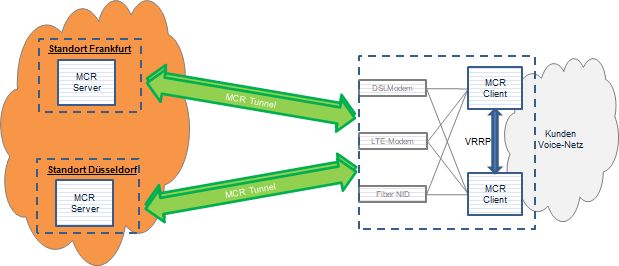Multichannel
In the conventional PSTN world, multiple support meant two to n primary rate connections to 2 to n exchanges.
The term "multiple support" in NGN / Voice over IP refers to the different levels of a VoIP connection.
On the one hand there is the IP connection route (VoIP) and on the other hand there is the voice connection route (VoIP). The two levels should be considered separately.
In order to achieve "real" multiple support to increase availability, the IP connection (hereinafter referred to as "cable path") and the SIP connection should each be designed multiple times.
In the case of multiple connections, such as wired lines (e.g. DSL, fiber optics, ...), terrestrial radio (e.g. LTE, 5G, ...) or satellite (e.g. geostationary, low orbit, ...), two cases must be distinguished:
• Discontinuation of the line path with discontinuation of the calls conducted via it
Without using a multichannel router, the VoIP calls are connected directly to the respective IP address of the line route. This means that if the line path is lost, the associated calls are also lost. Incoming and outgoing existing and newly beginning calls via the remaining line(s) are not affected.
• Elimination of the line route without ending the calls made via it
The various cable paths are to be routed to the VoIP telephone system/SBC via one or, for reasons of redundancy, two multichannel routers so that the loss of a cable path does not necessarily lead to an interruption in the call connections established over it. The multichannel router ensures that the VoIP traffic is routed via the available line paths and allows QoS and bandwidth aspects to be included in the selection.This is the preferred solution when using a TELEflash Voice DSL connection.
A multichannel router requires an appropriate infrastructure on the network side that supports multichannel bundling. TELEflash operates such a geo-redundant platform at the Düsseldorf and Frankfurt locations.

